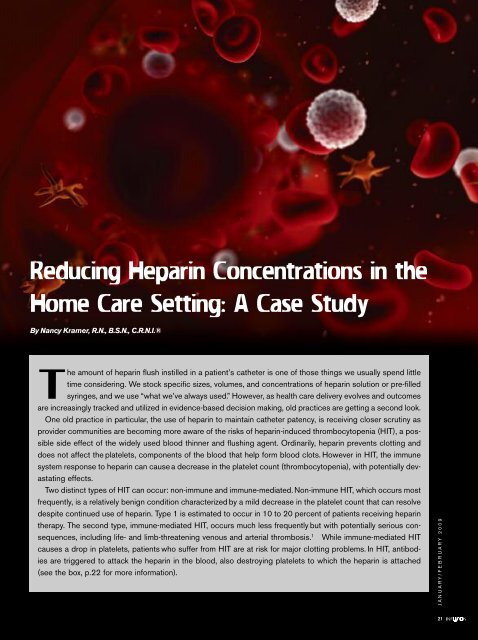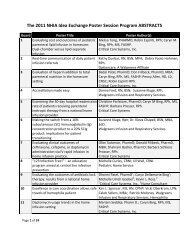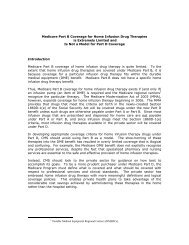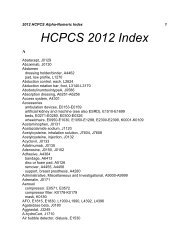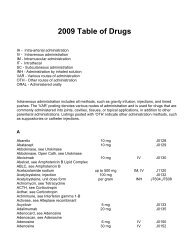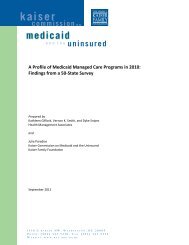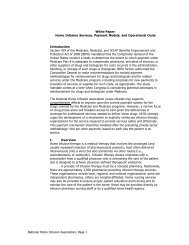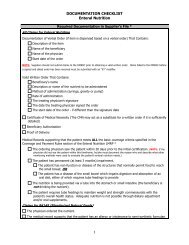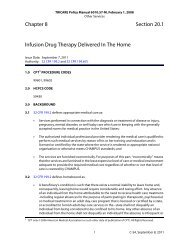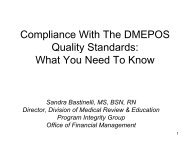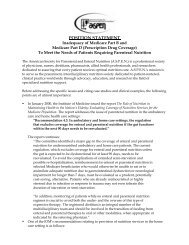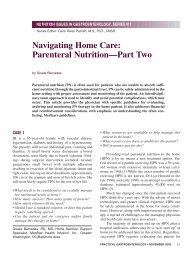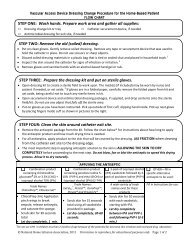Infusion Master - NHIA
Infusion Master - NHIA
Infusion Master - NHIA
- No tags were found...
You also want an ePaper? Increase the reach of your titles
YUMPU automatically turns print PDFs into web optimized ePapers that Google loves.
Reducing Heparin Concentrations in theHome Care Setting: A Case StudyBy Nancy Kramer, R.N., B.S.N., C.R.N.I.®he amount of heparin flush instilled in a patient’s catheter is one of those things we usually spend littleTtime considering. We stock specific sizes, volumes, and concentrations of heparin solution or pre-filledsyringes, and we use “what we’ve always used.” However, as health care delivery evolves and outcomesare increasingly tracked and utilized in evidence-based decision making, old practices are getting a second look.One old practice in particular, the use of heparin to maintain catheter patency, is receiving closer scrutiny asprovider communities are becoming more aware of the risks of heparin-induced thrombocytopenia (HIT), a possibleside effect of the widely used blood thinner and flushing agent. Ordinarily, heparin prevents clotting anddoes not affect the platelets, components of the blood that help form blood clots. However in HIT, the immunesystem response to heparin can cause a decrease in the platelet count (thrombocytopenia), with potentially devastatingeffects.Two distinct types of HIT can occur: non-immune and immune-mediated. Non-immune HIT, which occurs mostfrequently, is a relatively benign condition characterized by a mild decrease in the platelet count that can resolvedespite continued use of heparin. Type 1 is estimated to occur in 10 to 20 percent of patients receiving heparintherapy. The second type, immune-mediated HIT, occurs much less frequently but with potentially serious consequences,including life- and limb-threatening venous and arterial thrombosis. 1 While immune-mediated HITcauses a drop in platelets, patients who suffer from HIT are at risk for major clotting problems. In HIT, antibodiesare triggered to attack the heparin in the blood, also destroying platelets to which the heparin is attached(see the box, p.22 for more information).J A N U A R Y / F E B R U A R Y 2 0 0 921
Role of the Immune System in Heparin-Induced ThrombocytopeniaHeparin-induced thrombocytopenia type II (HIT) is the most frequent drug-induced,immune-mediated type of thrombocytopenia.The immune system response appears to be triggered by the immune complexthat forms between the heparin and platelet factor 4 (PF4). 2 The immune systemrecognizes this “heparin-PF4” complex as foreign, forming an antibody against it whichthen destroys the platelets. The drop in platelet count usually begins five to 10 days afterstarting heparin, although a rapid decline can occur in a patient who has antibodies fromrecent heparin use (within the past three months). 3The thrombocytopenia is generally moderate with a median platelet nadir of 55 to 60 X109/L. 4 As the platelet count falls to less than 100,000, or 50 percent of baseline, microparticlesare released from the platelets that are thought to lead to prothrombotic activity.Thrombosis associated with HIT occurs in up to 50 percent of all cases, with a 20 to 30 percentrisk of death.Although HIT is caused by an immune system reaction to heparin, it is not a true allergy.The PF4 antibody that causes HIT usually disappears after three months, permitting safeheparin re-exposure in selected patients (e.g., heart surgery patients) despite a history ofHIT. All patients with a history of HIT should be tested for PF4 antibody before re-exposure toheparin. When heparin is re-introduced before the PF4 antibody has been eliminated from thebloodstream, a more rapid onset of HIT can be triggered. 5J A N U A R Y / F E B R U A R Y 2 0 0 9Diagnosis of HIT relies on astute patient assessmentand history, followed by laboratory confirmation.Symptoms of new blood clot formation are oftenthe first indications of HIT, including pain or tenderness,sudden swelling, discoloration, visibly dilatedveins, and skin that is warm to the touch. Pulmonaryembolism can occur if a clot becomes dislodged inthe pulmonary vasculature, and may present as shortnessof breath, rapid pulse, sharp chest pain, dizziness,or feelings of anxiety and diaphoresis.Other signs of HIT can include bruising or blackeningaround heparin injection sites as well as the fingersand toes, which are susceptible to the smallclots that can form with HIT. Laboratory assessmentof the platelet count and PF4 antibody level in theblood can assist in confirming the diagnosis. Rapiddiagnosis of HIT is essential to effective treatment,as the temptation to treat thrombosis with heparinwould only worsen the condition. This is particularlychallenging when HIT develops after heparin hasalready been discontinued. Delayed-onset HIT isuncommon, but has been reported up to 40 days followingheparin exposure.So how likely is this problem to occur in the homesetting when the only source of heparin is from IVcatheter flushes? A recent study by Gettings, et al,found that 12 of 19 patients in a surgical ICU diagnosedwith HIT had only been exposed to 120 to 240units of heparin a day from catheter flushes. 6 Anotherstudy by Laster found that even a heparin-coatedcatheter could provide enough exposure to heparin toillicit an immune response and HIT. 7Until recently, rates of HIT have been poorly documented,leaving clinicians with an unclear picture ofjust how significant and widespread the problem maybe. However, recent studies in the hospital setting aredemonstrating an increased incidence of HIT. Theyare also revealing varying levels of the condition. It isnow thought that lower levels of HIT, while not lifethreatening on their own, can make patients susceptibleto other health conditions ranging from bruisingto stroke.22
While research in the inpatient setting continues,data from the home care setting—specifically in homeinfusion—is scant at best. Significant challenges to datacollection exist, including cost and the relatively shorttime that patients are on service compared to the trajectoryof HIT. The fact is although we may not see acase of HIT develop in a patient, we don’t know ifpatient exposure to heparin while on home infusion servicedoesn’t contribute to a problem later in the continuumof care.For this reason, even in the absence of data, anincreasing number of practitioners are asserting thatpatient exposure to heparin should be reduced as aprecautionary measure. In the home and alternatesiteinfusion practice, this can be accomplished byusing lower concentrations of heparin in routinecatheter flushing.Some in our industry may question the value ofadopting this as a policy and procedure—largelybecause of fears that catheter occlusions ratescould increase. In the following case study, oneinfusion provider organization lowered heparin concentrationswhile maintaining catheter patencyrates. Their story demonstrates that it is possible tolower patient exposure to heparin, and thus reducethe risk of HIT, without the detrimental effect ofincreased occlusions.Nancy Kramer, R.N., B.S.N., CRNI ® , is <strong>NHIA</strong>’s Vice President ofClinical Affairs. She can be reached at (513) 515-9440 ornancy.kramer@nhia.org.University of Iowa Community HomeCare: A Retrospective Data ReviewBy Kelli Krutsinger, R.N., B.S.N., C.R.N.I. ®Prior to November 2006, the University of IowaCommunity HomeCare’s practice was to flushbefore and after administration of all therapiesusing the SASH (saline, antibiotic, saline, heparin) technique.In addition, un-used lumens were flushed once aday. PICCs and tunneled catheters were flushed with3cc, and implanted ports with 5cc. Using heparin concentratedat 100U/mL meant that a patient with a doublelumen PICC line receiving a once-a-day antibioticwas receiving 400U of heparin per day.While at the <strong>Infusion</strong> Nurses Society (INS) 2007fall conference in Washington, D.C, I attended a lectureon HIT. The speaker indicated that flushing acentral venous catheter (CVC) with only 400U ofheparin a day was enough to cause heparin-inducedthrombocytopenia. 6Based on this new information, I decided that ourorganization should re-evaluate its procedures withthe idea of reducing overall patient exposure toheparin. We had two patients that had been taken offof heparin due to suspected HIT and we did notwant to put any of our patients at an increased risk.I began reviewing the literature to determine a safeand effective heparin concentration. The first referenceI checked was the 2006 INS Standards ofPractice, which note that flushing vascular accessdevices with a heparin solution will ensure patency. 8However, the standard on flushing notes the possibilityof HIT and suggests using the lowest possibleconcentration of heparin.I continued searching the literature looking for recommendationsfor heparin concentration for CVCflushes. While I wasn’t able to find specific recommendationsfor the home setting, one article showedthat HIT occurred in patients with as little as120U/day of heparin. 6Taking all this information into account, our organizationdecided to change its heparin flush protocol. InFebruary 2006, we made the switch from a heparinconcentration of 100U/mL to 10U/mL. We continuedto use 3cc flushes on PICCs and tunneled catheters,and 5cc flushes on implanted ports. The ports onlyreceive 100U/mL of heparin when they are deaccessed.We continued to use the same injection capwe were using for a year prior to the introduction of thenew heparin flush protocol.The transition has gone very smoothly, and, mostimportantly, we have maintained our catheter out-J A N U A R Y / F E B R U A R Y 2 0 0 923
Exhibit 1Occlusion Rates Before and After New Heparin Flush ProtocolsTime Period PICC Lines Occlusions Occlusion RateBefore (2/19/2006 – 2/18/2007) 277 9 3.25%After (2/19/2007 – 2/18/2008) 329 8 2.43%Source: University of Iowa Community HomeCareData collection is key to understanding the outcome of a change in clinical procedures, andsharing this information contributes to the body of home infusion clinical knowledgeJ A N U A R Y / F E B R U A R Y 2 0 0 9comes throughout and following the heparin concentrationchange. We were encouraged by the fact thatwe had no increase in occlusion rates of CVCs followingthe transition, which we defined as a line thatwill not aspirate or flush (see Exhibit 1). In addition,we have not received any reports of patients diagnosedwith HIT since we made the change. We willcontinue to use the 10U/mL heparin, as we evaluatethe feasibility of a change to saline-only flushes.ConclusionThe concentration of heparin used to routinely flushvascular access devices must be carefully evaluated inlight of the risk for heparin-induced thrombocytopeniain susceptible patients. In the absence of home infusionbased clinical research, providers are encouraged toexamine their internal patient outcomes in the applicationof evidence-based research from the hospital setting.Data collection is key to understanding the outcomeof a change in clinical procedures, and sharingthis information contributes to the body of home infusionclinical knowledge.Kelli Krutsinger, R.N., B.S.N., C.R.N.I. ® , is the Nurse Manager atUniversity of Iowa Community HomeCare. She can be reached byphone at (319) 337-8522 or by e-mail at krutsingerk@healthcare.uiowa.edu.References1. Franchini, Massimo. Heparin-induced thrombocytopenia:An update. Thrombosis Journal.2005;(14).2. McNulty I, Eliezer K, Kim K. Thombocytopenia followingheparin flush. Progress in CardiovascularNursing. 2007; 20(4): 143-147.3. Swanson, Joseph. Heparin-Induced Thrombocytopenia.Journal of <strong>Infusion</strong> Nursing. 2007; 30(4): 232-240.4. Warkentin TE. Platelet count monitoring and laboratorytesting for heparin-induced thrombocytopenia.Arch Pathol Lab Med. 2002; 126: 1415-1423.5. Baroletti SA, Goldhaber SZ. Heparin-inducedthrombocytopenia. Circulation. 2006; 114:e355-e356.6. Gettings E, Brush K, VanCott E, Hurford W.Outcome of postoperative critically ill patients withheparin-induced thrombocytopenia: An observationalretrospective case-control study. Crit Care.2006; 10(6): R161.7. Laster JL, Nichols WK, Silver D. Thrombocytopeniaassociated with heparin-coated catheters inpatients with heparin-associated anti-platelet antibodies.Arch Internal Med. 1989; 149:2285-2287.8. <strong>Infusion</strong> Nurses Society (INS). <strong>Infusion</strong> NursingStandards of Practice. 2006; 29; S56.24
A clear solution®Immune globulin intravenous (human)5% solvent/detergent treatedIf you’re thinking about IGIVtreatment, now’s the time toconsider octagam ® . With aproven record of safety, tolerabilityand efficacy 1 ,octagam ® comesready to use and can be stored atroom temperature for 24 months.If you think octagam ® could bethe right solution for you andyour patients please call us tollfree on 866-766-4860 orvisit us during the Baltimoreconference at booth #420.IMPORTANT SAFETY INFORMATIONoctagam ® is contraindicated in individualswith intolerance to immunoglobulins,especially in immunoglobulin A (IgA)deficiency, when the patient has IgEmediated antibodies to IgA.Immune Globulin intravenous (Human)(IGIV) products have been reported to beassociated with renal dysfunction, acuterenal failure, osmotic nephrosis, and death.Other possible side effects with octagam ®include: aseptic meningitis, hemolysis,transfusion-related acute lung disease(TRALI) and thrombotic events.Immune Globulin Intravenous (Human)products have been reported to beassociated with various minor reactions,such as headache, chills, backache, chestpain, fever, allergic reactions, arthralgia,dizziness, changes in blood pressure,cutaneous reactions and/or nausea andvomiting. Cases of reversible asepticmeningitis and migraine and isolated casesof reversible hemolytic anemia andreversible increases in liver function testshave been observed with octagam ® .Immediate anaphylactic andhypersensitivity reactions are a remotepossibility.As with all medicines made from humanplasma, the risk of spreading infectiousagents, including viruses, cannot becompletely eliminated.Some types of blood glucose testingsystems falsely interpret the maltosecontained in octagam ® as glucose. This hasresulted in falsely elevated glucose readingsand, consequently, in the inappropriateadministration of insulin, resulting inlife-threatening hypoglycemia.See brief summary of PI on facing page.1Ochs HD, Pinciaro PJ and the octagam ® StudyGroup. octagam ® 5%, an Intravenous IgG Product,is Efficacious and Well Tolerated in Subjects withPrimary Immunodeficiency Diseases. J. ClinImmunol 2004,24;3:309-314
octagam ®Immune Globulin Intravenous (Human) 5%Solvent/Detergent TreatedBrief SummaryPlease consult Package Insert for full prescribing informationoctagam ® is indicated for the treatment of primary immunedeficient diseases, such as: congenital agammaglobulinemiaand hypogammaglobulinemia, common variable immunodeficiency,Wiskott-Aldrich syndrome and severe combinedimmunodeficiencies.CONTRAINDICATIONSIntolerance to homologous immunoglobulins, especially invery rare cases of immunoglobulin A (IgA) deficiency, whenthe patient has IgE mediated antibodies to IgA.WARNINGSImmune Globulin intravenous (Human) (IGIV) productshave been reported to be associated with renal dysfunction,acute renal failure, osmotic nephrosis, anddeath. Patients predisposed to acute renal failureinclude patients with any degree of pre-existing renalinsufficiency, diabetes mellitus, age greater than 65,volume depletion, sepsis, paraproteinemia, or patientsreceiving known nephrotoxic drugs. Especially in suchpatients IGIV products should be administered at theminimum concentration available and the minimumrate of infusion practicable. While these reports ofrenal dysfunction and acute renal failure have beenassociated with the use of many of the licensed IGIVproducts, those containing sucrose as stabilizeraccounted for a disproportionate share of the totalnumber.octagam ® does not contain sucrose.See PRECAUTIONS and DOSAGE AND ADMINISTRA-TION sections for important information intended toreduce the risk of acute renal failure.octagam ® , should only be administered intravenously. Otherroutes of administration have not been evaluated.octagam ® should be given at the infusion rate under DOSAGEAND ADMINISTRATION at least until the physician has hadadequate experience with a given patient.Immediate anaphylactic and hypersensitivity reactions are arare possibility. Epinephrine should be available for treatmentof any acute anaphylactoid reactions.octagam ® contains only trace amounts of IgA (


